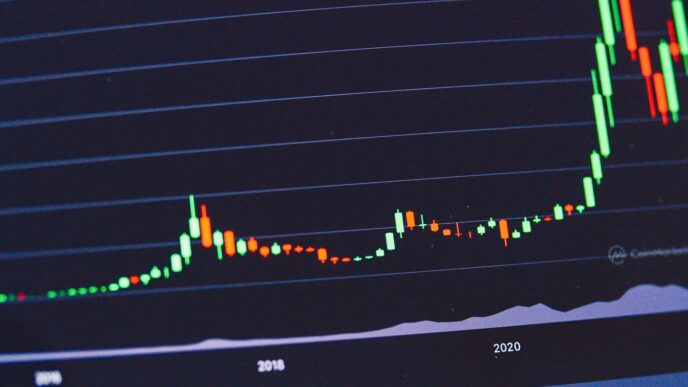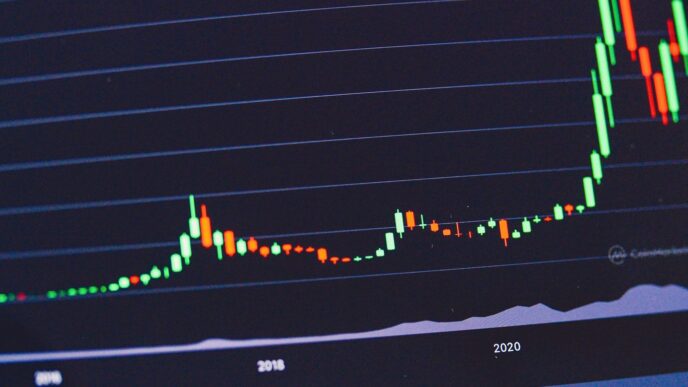So, what’s going on with crypto? It seems like just yesterday everyone was talking about how high prices were going, and now, suddenly, cryptocurrencies are crashing. If you’re wondering why are cryptocurrencies crashing, you’re not alone. It’s a big question, and there are a lot of moving parts. Let’s dig into some of the main reasons why the crypto market is taking a hit in 2025.
Key Takeaways
- Government actions and promises that don’t pan out can mess with crypto prices.
- Big security problems, like exchange hacks, make people not trust crypto as much.
- Crypto markets can act like bubbles, with prices going up fast then falling hard.
- The overall economy, like interest rates, can make people less likely to buy risky stuff like crypto.
- Too many new, low-value coins can make people lose interest in the whole market.
Political Maneuvers and Policy Missteps

Tariffs and Trade Tensions Impacting Crypto
So, things in the crypto world have been a bit wild lately, right? One thing that’s been adding to the chaos is all the political stuff happening. Remember when President Trump slapped those tariffs on imports from Mexico and Canada? Yeah, that sent ripples through everything, including crypto. The fear of trade wars makes investors nervous, and they tend to pull back from anything seen as risky, like Bitcoin. It’s all connected, even if it doesn’t seem like it at first.
Unfulfilled Promises of Pro-Crypto Policies
Okay, so a lot of people in the crypto community were really hoping that the government would be all about digital assets. There was a lot of talk during the campaign about being "crypto-friendly." But honestly, the pro-crypto policies? They’re moving at a snail’s pace. This slow action has led to frustration and uncertainty, which, of course, messes with the market. People were expecting one thing, and they got another. federal actions have brought cryptocurrencies back into national focus, sparking renewed policy discussions around their regulation and impact.
Governmental Stance on Digital Assets
The overall stance of governments on digital assets is a big deal. It’s not just about specific policies, but also the general vibe. Are they supportive? Skeptical? Hostile? This affects how people see crypto. If governments are constantly talking about cracking down or banning things, it makes investors nervous. On the other hand, if they’re exploring ways to integrate crypto into the financial system, it can boost confidence. It’s a delicate balance, and right now, there’s a lot of uncertainty in the air.
Major Security Breaches and Loss of Trust

It’s hard to ignore the elephant in the room: security. Or, more accurately, the lack of security that’s been plaguing the crypto world. It feels like every other week there’s another headline about a major breach or hack. And honestly, it’s starting to wear people down. All this uncertainty is making people nervous about keeping their money in crypto.
The Bybit Breach: A Wake-Up Call for Security
Okay, so the Bybit thing was HUGE. I mean, a staggering $1.5 billion in Ether vanished into thin air. It was like something out of a movie. This Bybit breach really shook things up. People started questioning whether these exchanges were really as secure as they claimed to be. It definitely made me think twice about where I keep my crypto. It’s not just about the money, it’s about the trust. When an exchange can’t protect your assets, it’s hard to have faith in the whole system.
Impact of Exchange Hacks on Investor Confidence
These hacks aren’t just isolated incidents; they have a ripple effect. Every time an exchange gets hit, investor confidence takes another nosedive. It’s like a constant drip, drip, drip of bad news that erodes trust over time. The Cryptocurrency Fear and Greed Index has been all over the place, but lately, it’s been stuck in "Extreme Fear" territory. And it’s easy to see why. Who wants to invest in something that feels like a ticking time bomb? It’s a vicious cycle: hacks happen, confidence drops, prices fall, and then people panic and sell.
Safeguarding Digital Assets in a Volatile Market
So, what can you do? Well, it’s all about taking precautions. Here are a few things I’ve been trying to do:
- Use hardware wallets: Get your crypto off the exchanges and into cold storage. It’s a pain, but it’s way safer.
- Diversify your holdings: Don’t put all your eggs in one basket. Spread your investments across different cryptocurrencies and exchanges.
- Stay informed: Keep up with the latest security news and be aware of potential threats. Knowledge is power.
- Be skeptical: If something sounds too good to be true, it probably is. Watch out for scams and phishing attempts.
It’s a wild west out there, and you need to protect yourself. It’s not fun, but it’s necessary. The more we focus on security, the better chance we have of restoring faith in the digital asset platforms and getting the market back on track.
Understanding the Cryptocurrency Bubble Phenomenon
Defining a Cryptocurrency Bubble
Okay, so what is a crypto bubble anyway? Basically, it’s when the price of a cryptocurrency goes way beyond what it’s actually worth. Think of it like this: everyone’s super hyped, thinking the price will just keep going up, up, up. But, like any bubble, it’s super fragile and can pop at any moment, sending prices crashing down. It’s happened before, and it’ll probably happen again. The TechAnnouncer article probably has some good insights on which cryptos might be overvalued right now.
Historical Parallels with Financial Bubbles
Crypto bubbles aren’t new. History is full of them! Remember the Dot-Com Bubble back in the late 90s? Internet stocks went crazy, then BAM! It all collapsed. Or the housing bubble in 2008? Huge mess. The same pattern shows up in crypto: prices skyrocket, then plummet. It’s like a cycle. Here’s a quick breakdown:
- Boom: Prices start climbing as more people invest.
- Euphoria: Everyone wants in, even if they don’t know what they’re doing. Prices get way too high.
- Panic: The market crashes as people try to sell fast, driving prices down even further.
The Cycle of Boom, Euphoria, and Panic
So, how does a crypto bubble actually form? It’s not like it happens overnight. It’s a process. First, there’s speculation and FOMO (fear of missing out). Social media and news can really fuel this. Then, you see a sharp increase in trading volumes. Lots of people are buying and selling, driven by emotion, not real value. Over-leveraging is another sign – people borrowing money to trade, which makes things even riskier. And then there’s the flood of new projects, all promising big returns but not really offering much. It’s a recipe for disaster. Keep an eye on the government stance on digital assets because that can also trigger a panic sell.
Macroeconomic Headwinds and Market Sensitivity
It’s not just crypto-specific problems causing the downturn. The overall economic climate plays a huge role. Think of it like this: crypto doesn’t exist in a vacuum. What happens in the wider world of finance definitely impacts Bitcoin’s price.
Rising Interest Rates and Risk Aversion
When interest rates go up, people tend to pull their money out of riskier investments, and crypto definitely falls into that category. Higher rates make safer investments like bonds more attractive. It’s a pretty simple equation: why risk your money on something volatile when you can get a decent return with less risk?
Global Economic Downturns and Crypto
If the global economy is struggling, people have less money to invest in speculative assets. During the COVID-19 pandemic, we saw a massive dip, but then government stimulus helped it recover. A recession in Europe, for example, could easily trigger another sell-off in the crypto market. People get scared, they sell off assets to cover immediate needs, and crypto gets hit hard. It’s a domino effect.
Cryptocurrency’s Vulnerability to External Shocks
Crypto is still seen by many as a ‘risk-on’ asset. This means that any unexpected bad news – whether it’s political instability, a natural disaster, or a major economic announcement – can send investors running for the exits. Crypto often gets sold off first. It’s like when the stock market reacts to job data, or Fed Watch announcements. The table below shows how different events can impact crypto:
| Event | Potential Impact |
|---|---|
| Interest Rate Hike | Price decrease due to risk aversion |
| Recession Announcement | Sell-offs due to fear and liquidity concerns |
| Geopolitical Instability | Increased volatility and potential price drops |
| Positive Economic News | Potential price increase due to increased confidence |
It’s a wild ride, and external factors make it even more unpredictable.
Market Saturation and Diluted Investor Interest
The Proliferation of New Tokens and Projects
It feels like every day there’s a new cryptocurrency popping up. Seriously, where do they all come from? This explosion of new tokens and projects is causing some serious market saturation. It’s getting harder for legitimate projects to stand out from the noise. Think about it: back in 2020, there were maybe a few hundred coins worth paying attention to. Now? Thousands. It’s overwhelming, and a lot of these new projects are, let’s be honest, pretty sketchy. It’s like the wild west out here, and not in a good way. This flood of new crypto projects definitely contributes to the overall downturn.
Impact of Low-Value Assets on Market Correction
All these low-value assets are dragging the whole market down. When you have a ton of coins with tiny market caps, they’re super vulnerable to price manipulation and pump-and-dump schemes. People see these coins going up like crazy, jump in hoping to make a quick buck, and then get burned when the price crashes. This erodes investor confidence and makes people wary of the entire crypto space. Plus, it diverts funds away from more established cryptocurrencies that might actually have some long-term potential. It’s a vicious cycle. The meme coin craze definitely didn’t help, with coins promoted by figures like President Trump seeing their values plummet.
Shifting Investor Focus to Established Cryptocurrencies
Smart investors are starting to realize that all these new, unproven coins are a huge risk. They’re moving their money back into more established cryptocurrencies like Bitcoin and Ethereum. It’s a flight to safety, basically. People are tired of getting burned by these fly-by-night projects and are looking for something a little more stable, even if the potential gains aren’t as high. This shift in focus is leaving a lot of these smaller coins in the dust, contributing to the overall market correction. It’s a sign that the market is maturing, but it also means that a lot of people are going to lose money along the way. The regulated Bitcoin futures trading volume is a good indicator of this shift.
Regulatory Scrutiny and Compliance Challenges
SEC Crackdowns on Unregistered Securities
The SEC’s increased focus on digital assets has led to more enforcement actions. They’re really going after projects that look like unregistered securities offerings. It’s not just about the big names either; smaller projects are feeling the heat. This has caused a lot of uncertainty, especially for new projects trying to get off the ground. The crackdown on unregistered securities offerings is a big deal.
The Rise of KYC and AML Requirements
Know Your Customer (KYC) and Anti-Money Laundering (AML) rules are becoming standard in the crypto world. Exchanges and token issuers now have to collect more information about their users. This is to prevent illegal activities like money laundering and terrorist financing. While it makes the crypto space safer, it also adds complexity and cost for businesses. Some users also worry about privacy. It’s a balancing act between security and freedom. New York is working to disrupt cross-border crypto scams as well.
Navigating the Evolving Regulatory Landscape
Keeping up with crypto regulations is a full-time job. The rules are constantly changing, and they vary from country to country. What’s legal in one place might be illegal in another. This makes it hard for businesses to operate globally. They need to have legal teams that understand all the different regulations. Some countries, like Nauru, are even creating dedicated regulators for crypto. It’s a complex world, and it’s only getting more complex.
Expert Warnings and Market Predictions
Economists’ Concerns Over Rapid Growth
Okay, so, not everyone is super thrilled about crypto’s wild ride. You’ve got economists out there raising eyebrows, and honestly, it’s probably smart to listen. They’re seeing echoes of past bubbles, and nobody wants a repeat of that. The speed at which crypto values have shot up is making some experts nervous. It’s like, yeah, gains are cool, but is it real?
Identifying Potential Triggers for a Market Correction
So, how do we know when things are about to go south? Well, there are a few things to keep an eye on. First, watch out for SEC crackdowns on unregistered securities. If the SEC starts dropping the hammer, that could spook investors. Also, keep an eye on the Fear and Greed Index. When it hits "Extreme Fear," that’s usually a bad sign.
Here’s a quick rundown of potential triggers:
- Market Saturation: Too many new coins flooding the market. It’s like everyone’s got a crypto, and nobody knows which ones are legit.
- Macroeconomic Shifts: Rising interest rates or a global recession. Basically, if the economy tanks, people are less likely to throw money at risky stuff like crypto.
- Major Project Failures: Think another Luna/UST situation. One big collapse can send shockwaves through the whole market. Remember the Bybit breach? That shook a lot of people up.
Navigating Volatility with Caution and Research
Alright, so the market’s looking shaky. What do you do? First off, don’t panic. Easier said than done, I know. But seriously, now’s the time to take a deep breath and think rationally. Do your homework. Understand what you’re investing in. Don’t just jump on the bandwagon because your neighbor’s getting rich (or says they are). And maybe, just maybe, consider taking some profits off the table. It’s always better to be safe than sorry. Keep an eye on crypto finance magnates for more insights.
Here’s a little table to help you stay grounded:
| Strategy | Description . I’m not saying it’s a guarantee, but it’s something to think about. And hey, maybe Trump’s pro-crypto stance will actually pan out. Who knows? Just don’t bet the farm on it.
Conclusion: What Now for Crypto?
So, what’s the deal with crypto right now? It’s been a wild ride, that’s for sure. We’ve seen some big ups and downs, and it’s easy to feel a bit lost in all the noise. The truth is, the crypto world is still pretty new, and it’s always changing. Things like new rules, big hacks, or even just what people are saying online can really shake things up. It’s kind of like learning to ride a bike; you’re gonna wobble and maybe even fall a few times before you get the hang of it. For anyone thinking about getting into crypto, or even if you’re already in it, just remember to be careful. Do your homework, don’t put in more money than you can afford to lose, and try to keep up with what’s happening. Nobody has a crystal ball, but being smart about it is always a good idea.
Frequently Asked Questions
Why do cryptocurrencies sometimes crash?
Many things can make crypto prices drop. Sometimes, it’s because governments make new rules that make it harder for crypto to grow. Other times, big hacks or scams make people lose trust. Also, if the global economy is doing badly, people might sell off their crypto.
What is a cryptocurrency bubble?
A crypto bubble happens when the price of a cryptocurrency goes up really fast, much more than it should, because lots of people are buying it hoping to get rich quick. It’s like a balloon that keeps getting bigger until it pops, and then prices fall sharply.
When might a crypto bubble burst?
It’s hard to say exactly when a crypto bubble will burst, but there are signs to watch for. If too many new, not-so-good coins are being made, or if interest rates go up, or if a major crypto project fails, these can all make the market drop.
Are crypto markets always so up and down?
Yes, crypto markets are known for big ups and downs. This is because they are still quite new and can be easily affected by news, rumors, and how many people are buying or selling. It’s like a roller coaster ride.
What should I do if I want to invest in crypto?
If you’re thinking about putting money into crypto, it’s smart to be careful. Do your homework, understand that prices can change a lot, and only put in money you can afford to lose.
How do governments affect crypto prices?
Governments can make new laws about how crypto is bought, sold, and used. They might also decide to tax crypto or try to stop bad guys from using it for illegal stuff. These rules can make investors nervous and affect prices.














